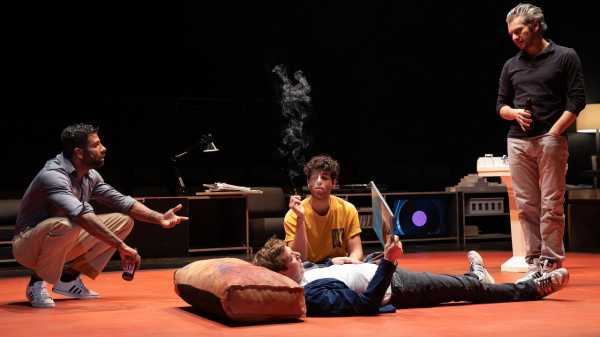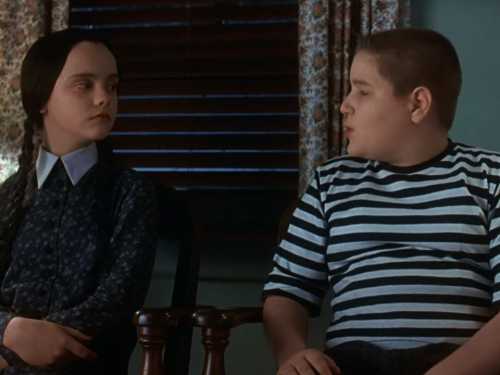
The proverbial straw that breaks “A Little Life”—the Dutch stage adaptation of Hanya Yanagihara’s maximally tortured, seven-hundred-and-twenty-page blockbuster 2015 novel—is a truck. Not to be confused with the car that appears in an eleventh-hour flashback, which explains the mysterious disability of our hero, Jude. No, the truck bit comes just a bit later, during the last sliver of the production’s four-hour-and-ten-minute slog.
The director Ivo van Hove’s production with the Internationaal Theater Amsterdam has put the audience at BAM’s Howard Gilman Opera House through a lot in that time, and depending on viewers’ knowledge of Yanagihara’s brutal plot, some of that taxing material has been a surprise. But the straw moment is easy to see coming: first, Jude says (in Dutch, translated for the audience in English supertitles), “You know, I’ve been lucky all my life.” Uh oh. Then a kindhearted man in a snuggly cardigan wanders centerstage to say he’s popping out on an errand. If we have learned one thing in the past five years (from “The Inheritance” on Broadway, from Taylor Swift), it is that cardigans mean sorrow.
After an early feint toward being a story of four destined-to-be-rich friends—the lawyer Jude (Ramsey Nasr), the painter JB (Majd Mardo), the actor Willem (Maarten Heijmans), and the architect Malcolm (Edwin Jonker)—making it in New York, the play turns its attention to Jude and never looks away. He’s mysterious, even to the friends who live with him at various points. He can’t be touched, won’t talk about his childhood, suffers from a persistent weakness in his legs, doesn’t like people to see his naked flesh. What do you think happened to him? Unpacked gradually over the course of the evening, it’s a litany of torment: he suffered sexual abuse as a tiny boy in the clutches of evil monks, escaping them only to endure years of more abuse at the hands of his surrogate father, rapist, and pimp Brother Luke (Hans Kesting), escaping him only to be caught, imprisoned, and serially assaulted by a roving psychopath, Dr. Traylor (Kesting again).
In a way, we have been warned that there will be atrocity beyond all reasonable expectation—Yanagihara names her main character Jude St. Francis. We surely remember the serial agonies that afflicted Thomas Hardy’s Jude (the obscure one): grim anguish, a lover terrified of sex, the death of his children. Various characters in “A Little Life” suffer in these same ways. (Jude’s past also sounds like something out of the Marquis de Sade’s “Justine, or the Misfortunes of Virtue,” another book with a dim view of monasteries.) We know St. Francis, too, who manifested Christ’s stigmata. Jude cuts himself so much and so deeply in van Hove’s production that actors spend significant time mopping the blood-red floor. What’s the connection between sainthood and these scars? Is the piece implying a path to exaltation through pain? Is there some kind of flagellant’s spirituality at work here?
Jude’s adult life in van Hove’s “A Little Life” is full of gifts, even if psychic wounds prevent his enjoying them: spectacular wealth; universal lovability (when he wakes up from a medical procedure, his friends tell him “You’re patient. You’re generous. You’re the best listener I know”); and a bouquet of genius-level talents, such as singing, gardening, cooking, well-compensated legal expertise, and (largely unreferred to) mathematical gifts. Certainly Jude isn’t of this earth, where ruined childhoods rarely lead to such gilded lives. Jude has a lot of backstory and many skills, but this stage adaptation, by Koen Tachelet, gives us very little to fill in this outline. His friends claim he’s a good listener, but in more than four hours, we never see him listen to anyone. As Parul Sehgal noted in “The Case Against the Trauma Plot” in this magazine, “trauma trumps all other identities, evacuates personality, remakes it in its own image.” To show us an empty man, hollowed out by atrocity, would be one thing, but the other characters insist that, in fact, Jude is a full person. Van Hove just doesn’t happen to demonstrate that in any scenes. He must have run out of time.
So when that truck inevitably hits in the show’s last moments, a string combo saws away on their instruments trying to make us sad about it—but a production that has been trying to balance its sadistic intensities tips, fatally and finally, into silliness. This affective collapse has destructive effects, which ripple in both directions.The moment’s absurdity casts a shadow on the suffering that preceded it—were those abuses nonsensical, cosmetic, and mechanical, too? A melodrama’s relationship to mood is fragile. It can’t sustain a giggle.
Also, I hate to be literal, but when during his long sexual enslavement did Jude study for the SAT? How did he get a scholarship to that fancy college where he met his adoring friends? On this planet—Hardy’s “blighted star”—the result of all this suffering wouldn’t be a frictionless entry into the high-shine, consumerist, aspirational New York élite.
A certain glossiness inheres to all van Hove projects, and sometimes his tendency to gorgeousity illuminates. He can be tremendous, for instance with classic playwrights: Shakespeare (the Dutch productions “Roman Tragedies” and the inventive “Kings of War”); Henrik Ibsen (a blistering New York Theatre Workshop “Hedda Gabler,” back in 2004); and Arthur Miller (particularly his “A View from the Bridge,” in 2015). Van Hove should be the right person for this adaptation; as a maker, he is sympatico with the material’s operatic, almost hysterical nature. He’s clearly called to cinema giallo-style works about persecution and abasement—even when the thinking in a work is pretty shallow, the aesthetics can be interesting—such as “The Damned,” which came to the Park Avenue Armory in 2018, and a version of Ayn Rand’s “The Fountainhead,” that gushed onstage at BAM in 2017. But when the material needs some discipline from him, self-indulgence reigns. This production is the latter case. When Yanagihara and van Hove mash pain and purchase power together, you get scenes like Jude setting his hand on fire—actual blazing fire with flames—while murmuring:
Smoking olive oil, Perugia,
have roasted funghi with Willem
a Tintoretto exhibit with Malcolm
at the Frick, a boy called Frick
the nights in the barn, the sex
With Brother Luke on a bale of hay . . .
. . . and . . .
. . . and salt!
Now, that’s appalling, and not just because Jude is so determined to harm himself.
As ever in a van Hove production, the set and lighting designer Jan Versweyveld acts as a kind of dramaturg, explaining the show’s priorities with yet another elegant, rather chilly room. He fills almost our entire visual field with that red floor, a gash that never heals. There’s a pedestal sink in the middle of it, Jude’s altar, where he slices his arm with razor blades, holding his arm and face up to Versweyveld’s annunciatory light. The playing space is ringed with furniture pieces that gesture at location: a kitchen where Jude’s adoptive father Harold (Jacob Derwig) cooks; JB’s studio, hung with paintings of the friends; a medical bed. Two video screens show constant, slow-motion video of New York streets, as if an editor were roving the streets to find the right location for a fashion shoot.
Van Hove’s most confident moments in “A Little Life” (if not the most palatable ones) are when he leans into a voyeuristic, ugly darkness. He lowers the lights and has the magnificent Kesting play Jude’s various persecutors as terrifying, sinuous beasts: Brother Luke, tears in his eyes, is a crocodile; Dr. Traylor hisses like a snake. Van Hove, though, hasn’t quite got the grit to stay down there in the swamp. As the play wraps up, he turns sentimental, even gluey, and he tries to gesture at transcendence. The aforementioned truck comes barrelling down the plot, and everybody starts talking mistily about the afterlife and reincarnation and peace. Maybe, Harold says, after Jude finally finally dies, his dead adopted son has turned into a flower on a rhododendron bush. Ugh. These final schmaltzy minutes sabotage the relentless hours that have gone before. Great theatre can be punishing, it can be cruel, it can even deliberately inflict harm. But glibness and bathos? Those hurt. ♦
Sourse: newyorker.com






